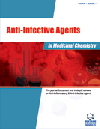- Home
- A-Z Publications
- Anti-Infective Agents in Medicinal Chemistry (Formerly Current Medicinal Chemistry - Anti-Infective Agents)
- Previous Issues
- Volume 8, Issue 4, 2009
Anti-Infective Agents in Medicinal Chemistry (Formerly Current Medicinal Chemistry - Anti-Infective Agents) - Volume 8, Issue 4, 2009
Volume 8, Issue 4, 2009
-
-
Editorial [Hot topic: Anti-Infective Agents in Medicinal Chemistry- Hot Topic: Fall of 2009 (Guest Editor: Paul B. Savage)]
More LessAuthors: Paul B. Savage and Mark L. NelsonEvery year the Interscience Conference on Antimicrobial Agents and Chemotherapy (ICAAC) meets in the Fall, to chronicle and describe the state-of-the-art in infectious diseases and chemotherapy, with the hope of highlighting new agents that look promising to treat Mankind's most dreaded pathogens. Unfortunately, this year fewer new agents are being described, although the clinicians will be out in full force, looking for ag Read More
-
-
-
Activities of Ceragenin CSA-13 Against Established Biofilms in an In Vitro Model of Catheter Decolonization
More LessAuthors: Jacob Pollard, Jon Wright, Yanshu Feng, Dianliang Geng, Carl Genberg and Paul B. SavageBacterial biofilms on medical devices are a primary source of infection, and efforts have been made to develop means of decontaminating colonized devices including hemodialysis catheter “lock” solutions. Because bacterial biofilms are inherently resistant to many antibiotics and widespread use of antibiotics contributes to resistance development, there is a need for new approaches to biofilm eradication. We hav Read More
-
-
-
Small Molecule Approaches Toward the Non-Microbicidal Modulation of Bacterial Biofilm Growth and Maintenance
More LessAuthors: Justin J. Richards and Christian MelanderBacterial biofilms are defined as a surface attached community of microorganisms that are protected by an extracellular matrix of biomolecules. Within a biofilm state, bacteria are more resistant to antibiotics and are inherently insensitive to antiseptics and basic host immune responses. The NIH has estimated that 65-80% of all microbial infections are biofilm-based. Biofilm infections of indwelling medical devices are also of Read More
-
-
-
Quorum-Sensing Inhibitors and Biofilms
More LessBacteria rely on chemical communication or quorum sensing to coordinate activities necessary for their survival in colonies. Among the numerous processes mediated by this intercellular communication is the formation of biofilms. The prevalence of biofilms in many different environments can be problematic. Their association to infectious diseases and their inherent ability increase antibiotic resistance in bacteria has led to a gr Read More
-
-
-
Peptidomimetics and their Applications in Antifungal Drug Design
More LessAuthors: Shoeib Moradi, Saeed Soltani, Alireza M. Ansari and Soroush SardariThe antimicrobial peptides represent diverse structures for drug design. They have been looked at as potential sources of new antimicrobial drugs to combat the increasing threat posed by multiple drug resistant microorganisms. Unfortunately, peptides themselves provide inferior drug candidates because of their low oral bioavailability, potential immunogenicity, poor in vivo metabolic stability, high molecular weight and Read More
-
-
-
Antiprotozoal Agents: An Overview
More LessAuthors: C. S. Graebin, F. D. Uchoa, L. S.C. Bernardes, V. L. Campo, I. Carvalho and V. L. Eifler-LimaThe therapy of parasitic diseases has relied, until recently, on the use of a very limited number of drugs, most of them of low efficacy, leading to side effects and in certain cases with high toxicity. This review focuses on the chemotherapy to treat diseases caused by Trypanosoma cruzi (Chagas' disease), Trypanosoma b. gambiense and Trypanosoma b. rhodesiense (sleeping sickness), Plasmodium (malaria) and Leishma Read More
-
-
-
Current Understanding of Polymyxin B Applications in Bacteraemia/ Sepsis Therapy Prevention: Clinical, Pharmaceutical, Structural and Mechanistic Aspects
More LessAuthors: Patrick Garidel and Klaus BrandenburgPolymyxin B (PMB) belongs to a class of antibiotics discovered more than six decades ago. PMB was used for various bacterial infection threatening, in particular to sepsis. Its use, however, was abandoned because of the observation of severe side effects. In the last years this view changed due to the appearance of multi-drug resistant Gram-negative pathogens, which were resistant to most available antibiotics, leading to a re-e Read More
-
Most Read This Month
Article
content/journals/aiamc
Journal
10
5
false
en


